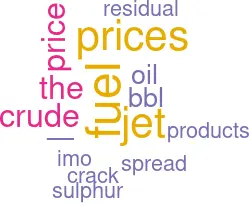Jet fuel: the IMO 2020 effect
November 2018


The two-year upward trend in crude and Jet A prices was reversed in November, with crude slipping to around $60/bbl and Jet A to $75.
The outlook for crude prices is generally promising, or at least a return to prices over $100/bbl looks unlikely (with the usual caveat about geopolitical events). According to an analysis by Bernstein, presented at a recent research conference, global capacity/demand patterns and inventory levels indicate a “price deck” of $70/bbl for 2019-2023, with the average prices likely to fluctuate in the $70s.
However, there is less positivity about the outlook for Jet A prices: specifically, the widening crack spread (the difference between the crude price and the refined product price), already evident in the current spot prices and on the futures markets, is expected to be maintained: Bernstein anticipate a $15/bbl or 25% crack spread. The reason lies not in the aviation industry but in the shipping industry.
Ships burn a residual fuel oil called Bunker C. This is a sludgy, rather nasty oil which is particularly high in sulphur. As well as pollution from sulphur which affects coastal communities, shipping pumps out more greenhouse gases than aviation — its contribution to anthropogenic global warming is estimated at around 5% as compared to aviation’s 3-3.5%.
The International Maritime Organisation (IMO, equivalent of ICAO) has been tightening its restrictions on Bunker C pollution since 2000, and has set a deadline of 2020 for cutting the permitted sulphur limit from the current 4.5% to 0.5% — the “IMO 2020” regulation.
The predicted effect will be to cut maritime demand for residual fuel oils by 1.8m bbl/day, and push up demand for the middle distillates, which include jet fuel, by an equivalent amount, with a consequent increase in price for these products. And because refiners cannot simply turn off the production of heavy products, the price of residual fuel oil is likely to halve (to the level at which it becomes competitive with coal as a fuel source for power stations), which means that refiners have to compensate for the losses in this product range by pushing up the prices of its more refined products, including jet fuel.
An important issue for airlines is that they generally use the crude oil futures markets to hedge — Ryanair and Southwest are exceptions, hedging specifically on jet fuel — so they may find themselves exposed to the increasing and unhedged crack spread.
Source: EIA
Source: IEA, Bernstein